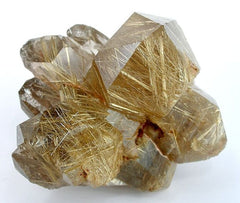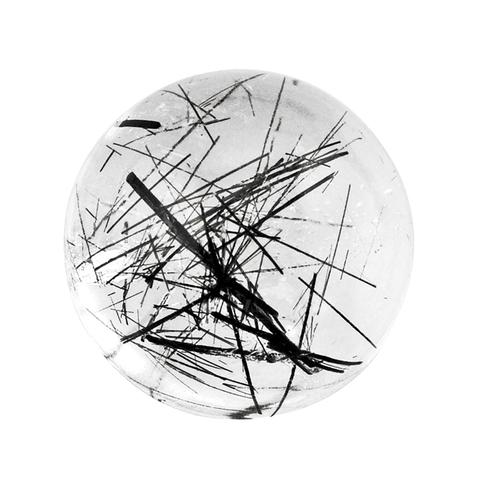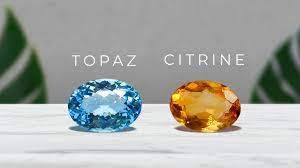Our Rutile Quartz Collection
Jun 07 2018 0 Comments Tags: gemstones, quartz, rutilated quartz, rutile, rutile quartz, store
We have recently received stock of a fabulous stone, which is part of the quartz family: the stunning rutilated quartz! So this month, we are bringing you a post to update you on this striking lesser-known stone.
 Rutilated quartz is a variety of quartz which contains needle-like inclusions of the titanium oxide mineral rutile. These inclusions range in colour from gold, to silver, copper-red, or black, and can be illuminated under the light to spectacular effect. Sometimes the inclusions are dark enough to make the quartz appear nearly opaque, and sometimes they are distributed much more sparsely. The inclusions range from thin, sparse, and parallel, to thick, dense, and criss-crossed. The pattern of rutile inclusions in each rutilated quartz stone makes it completely unique.
Rutilated quartz is a variety of quartz which contains needle-like inclusions of the titanium oxide mineral rutile. These inclusions range in colour from gold, to silver, copper-red, or black, and can be illuminated under the light to spectacular effect. Sometimes the inclusions are dark enough to make the quartz appear nearly opaque, and sometimes they are distributed much more sparsely. The inclusions range from thin, sparse, and parallel, to thick, dense, and criss-crossed. The pattern of rutile inclusions in each rutilated quartz stone makes it completely unique.
Natural rutile may contain up to 10% iron and significant amounts of niobium and tantalum, accounting for the reddish tone of some of the inclusions - indeed, rutile derives its name from the Latin 'rutilus', meaning 'red'. When the iron content is lower, it may appear darker, or even black in colour.

While many gemstones - including most varieties of transparent quartz - are valued most when they show no inclusions, rutilated quartz is valued specifically for the lovely patterns the golden needles of rutile can form. Rutilated quartz often has striking patterns and colours, and this combined with its affordability and excellent durability makes it perfectly suitable for jewellery. Most rutile quartz jewellery features cabochon gemstones, but faceted gems are available and are equally stunning (we have lots of different shapes and cuts available in our store!).
The main source of rutilated quartz is Brazil, with the other important source being India. It is encountered in other locations around the world but is much less common than in Brazil and India.

Other names for rutilated quartz include 'Goddess's Tresses', 'Cupid's Net', and 'Venus Hair', thanks to its hair-like golden inclusions. There is something almost supernatural about its glistening lustre, which can be incorporated into jewellery for extra glamour and sparkle!
Chemical Formula: SiO2 (quartz), TiO2 (rutile)
Colour: Yellow, brown
Mohs Hardness: 7
Crystal System: Hexagonal
Refractive Index: 1.54-1.55
Specific Gravity: 2.63-2.7
Transparency: Transparent to translucent
Luster: Vitreous
Cleavage: Indiscernible
The unique formation and appearance of rutilated quartz easily distinguishes it from all other gemstones, with the exception of rutilated topaz. Rutilated topaz is harder, has more brilliance, and its inclusions are limonite rather than rutile. Another less well-known related stone is tourmalinated quartz, which contains black or dark green tourmaline crystals instead of golden rutile.
 In terms of crystal healing and the stone's traditional uses according to folklore, rutilated quartz is said to enhance mental and physical stability, decision-making and self-reliance. Those who believe in the power of crystals particularly value rutilated quartz for its purported enhancement of clairvoyant powers.
In terms of crystal healing and the stone's traditional uses according to folklore, rutilated quartz is said to enhance mental and physical stability, decision-making and self-reliance. Those who believe in the power of crystals particularly value rutilated quartz for its purported enhancement of clairvoyant powers.
Taking care of your quartz stones or jewellery is relatively easy, as it is quite a durable stone. You can clean quartz stones with running water and a soft cloth - do not use abrasive cleaners to clean your crystals, as this can harm them.
Quartz does not scratch very easily, but it should be kept in a fabric-lined jewellery box or soft cloth away from other gemstones (such as jade, turquoise and pearls) as it is capable of scratching them.

0 comments





Leave a Comment